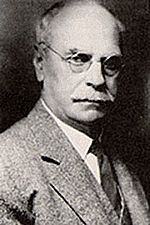Edwin Hall facts for kids
Quick facts for kids
Edwin Hall
|
|
|---|---|

Edwin Herbert Hall (1855-1938)
|
|
| Born | November 7, 1855 |
| Died | November 20, 1938 (aged 83) Cambridge, Massachusetts, United States
|
| Nationality | American |
| Alma mater | Johns Hopkins University Bowdoin College |
| Known for | Hall effect |
| Scientific career | |
| Fields | Physicist |
| Institutions | Harvard University |
| Doctoral advisor | Henry Augustus Rowland |
Edwin Herbert Hall (born November 7, 1855, died November 20, 1938) was an American physicist. He is most famous for discovering something called the Hall effect. Hall also studied how heat and electricity work together. He did this research at Harvard University. Besides his discoveries, he wrote many physics textbooks and guides for lab experiments.
Contents
Early Life and Education
Edwin Hall was born in Gorham, Maine, in the United States. He went to Bowdoin College in Brunswick, Maine, and finished his studies there in 1875.
Before continuing his own education, Hall worked as a school principal. He led Gould Academy from 1875 to 1876. After that, he was the principal of Brunswick High School from 1876 to 1877.
Later, he went to Johns Hopkins University for his advanced studies. He earned his Ph.D. degree in 1880. It was during this time that he made his very important discovery.
The Hall Effect
Hall discovered the Hall effect in 1879. He was working on his Ph.D. project in physics at the time.
How Hall Discovered It
For his experiments, Hall used very thin sheets of gold. He would place these thin gold sheets on a glass plate. Then, he would connect wires to different points along the gold sheet.
He passed an electric current through the gold. At the same time, he applied a magnetic field to the gold sheet. This magnetic field was placed at a right angle to the electric current.
What the Hall Effect Is
The Hall effect describes what happens next. When an electric current flows through a material, and a magnetic field is applied across it, a special voltage appears. This voltage is called the Hall voltage. It shows up on the sides of the material, opposite to where the current is flowing.
The amount of Hall voltage created depends on the material. It also depends on how strong the current and magnetic field are. The relationship between this voltage and the current is known as the Hall resistance. This resistance is a unique feature of the material.
In 1880, Hall's findings were published. They appeared in scientific journals like the American Journal of Science and the Philosophical Magazine.
Uses of the Hall Effect
The Hall effect is very useful today. It is used in many devices, especially as magnetic field sensors. You can find these sensors in many everyday gadgets.
It is also used in advanced technology. For example, it helps power high-efficiency electric engines. These engines are used in spacecraft to help them move through space.
Quantum Hall Effect
When a material is in a very strong magnetic field and at a very low temperature, something even more interesting happens. Scientists can observe the quantum Hall effect. This is a special version where the Hall resistance becomes "quantized." This means it can only take on specific, fixed values. Today, this quantum Hall effect is used as the official standard for measuring electrical resistance.
Later Career and Legacy
Edwin Hall became a professor of physics at Harvard University in 1895. In 1914, he took over a special position called the Rumford Professor of Physics. He retired from Harvard in 1921.
Hall passed away in Cambridge, Massachusetts, in 1938, at the age of 83. His discovery, the Hall effect, continues to be a very important concept in physics and technology.
Works by Hall
Edwin Hall wrote many articles for scientific journals. These articles covered topics like how heat moves through iron and nickel. He also wrote about the theory of how heat and electricity interact. Some of his published books include:
- The Teaching of Chemistry and Physics (1902), which he wrote with Alexander Smith
- College Laboratory Manual of Physics (1904; a newer version came out in 1913)
- Elements of Physics (1912)
 This article incorporates text from a publication now in the public domain: "article name needed". New International Encyclopedia. (1905).
This article incorporates text from a publication now in the public domain: "article name needed". New International Encyclopedia. (1905).
Images for kids
See also
 In Spanish: Edwin Herbert Hall para niños
In Spanish: Edwin Herbert Hall para niños


